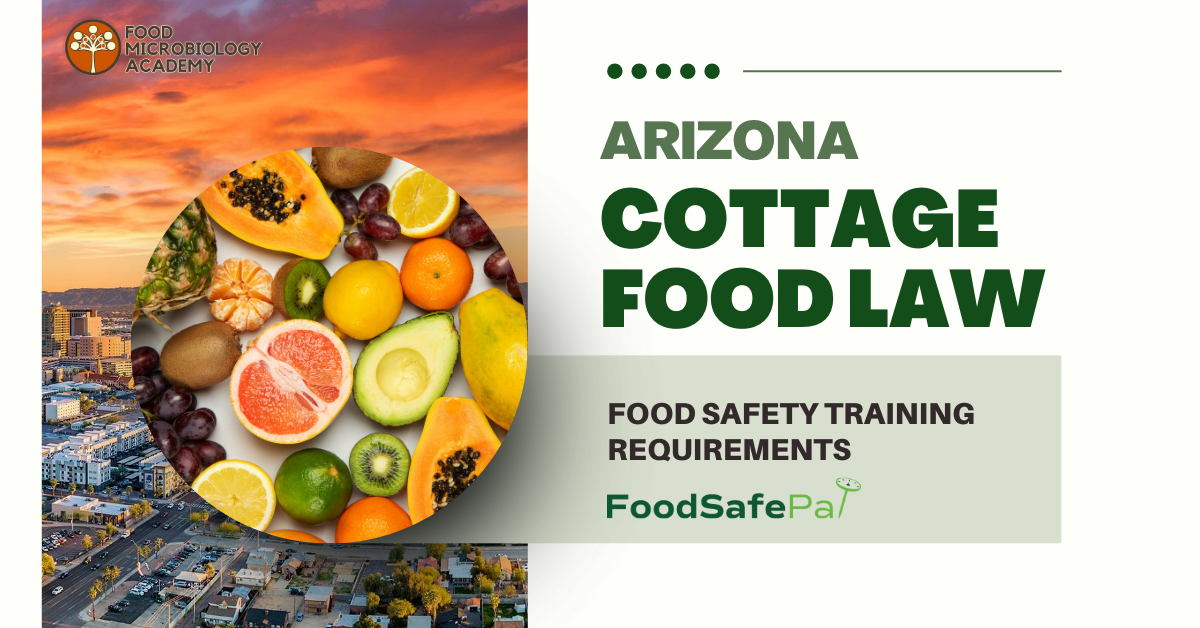Originally published by FoodSafePal® on 5 May 2024 We have a collaborative partnership with FoodSafePal to provide discounted food handler training to our food safety community here at Food Microbiology Academy. Just use our discount code “foodsafety1” during registration to grab a $5.00 USD discount! Cottage — or homemade — food businesses have increased in popularity as more people want to know where their food comes from and who makes it. Each state has its own regulations for cottage foods, including regulations related to food safety training. This article discusses the Arizona cottage food law, and whether you need food safety training to sell homemade food. Arizona’s cottage food program allows you to make homemade foods that don’t require time or temperature controls and sell them to people in- person or online, but only to addresses in Arizona. Here is a list of approved cottage foods: Conversely, Arizona’s cottage food law prohibits foods such as: You also cannot make and sell dog treats or pet foods as animal food is considered commercial feed and regulated by the Arizona Department of Agriculture. Because Arizona doesn’t regulate retail food establishments such as restaurants like they do cottage food businesses, Arizona will not inspect your home kitchen. Still, it’s your responsibility to ensure you follow the proper production guidelines to reduce the risk of spreading foodborne pathogens to your customers. Summary Under the Arizona cottage food program, you can make and sell foods that don’t require time or temperature controls, such as certain baked goods, sweets, honey, fruit jams, and roasted coffee beans, among others. Do you need food safety training to sell homemade food in Arizona? Arizona requires that you complete a food safety course before you can register for the state’s cottage food program to sell your homemade foods, no matter your county of residence. This training must be an ANSI-National Accreditation Board (ANAB)-accredited food handlers course, such as the one offered by FoodSafePal. Earn Your Food Handlers Card + Certificate to Sell Cottage Foods. This is accredited & meets Arizona’s cottage food law ENROLL NOW – use our discount code “foodsafety1” to receive $5.00 USD off any food handler training course at FoodSafePal. ANAB-accredited food handler training is the same training required for food employees at food establishments in certain Arizona counties. You can complete FoodSafePal’s ANAB-accredited online food handler program in under two hours. The course covers important food safety principles, such as: After the course, you must demonstrate your knowledge of these topics by passing a 40-question multiple-choice test, and answer at least 28 (70%) correctly. If you don’t pass the first time, you can retake it for free. After you pass, you’re issued a food handler certificate and card that you will need for registering your cottage food business. Your food handler certification cate and card will be good for three years from the date you earn it. Depending on which county you live in, you may need to bring your food handler certificate to your local health department and pay a conversion fee to be issued a county-specific food handler card. As part of the application process to register your cottage food business, you’re required to upload a copy of your food handler certificate, so don’t forget to save a PDF copy after you pass. You will also need to enter the expiration date of the food handler card, which will be three years from the date you passed. You must keep your certificate active while in business by retaking the course every three years to remain complaint with Arizona’s cottage food program. Summary Before you can produce and sell cottage foods, Arizona requires that you complete an ANAB-accredited food handler course, such as FoodSafePal’s. Labeling requirements. The only thing you need before you can submit your application to register for Arizona’s cottage food program is a copy of a food handler certificate from an ANAB-accredited provider, like FoodSafePal. However, it’s your responsibility to ensure you’re following the labeling requirements for your products. Arizona requires that you attach a label with the following information to each product: If your cottage food product was made in a facility for individuals with developmental disabilities, you must also include the following statement on the label, “This product was made in a facility for individuals with developmental disabilities.” Properly labeling your homemade goods allows you to sell your homemade goods from retail food establishments. Summary Arizona’s cottage food law requires that you attach a label to each food product. The label must include certain information, such as your name or business name, a list of ingredients, and the product’s production date. The bottom line Under the Arizona cottage food program, you can sell homemade foods that don’t require time or temperature controls directly to people within the state. However, before you can register for the Arizona cottage food program, you must complete an ANAB-accredited food handler course, such asFoodSafePal’s. Earn Your Food Handlers Card + Certificate to Sell Cottage Foods Accredited & Meets Arizona’s Cottage Food Law ENROLL NOW – use our discount code “foodsafety1” to receive $5.00 USD off any food handler training course at FoodSafePal. Arizona requires that each food product have an attached label that discloses certain information, such as who made the product and when and a list of the ingredients it contains.







